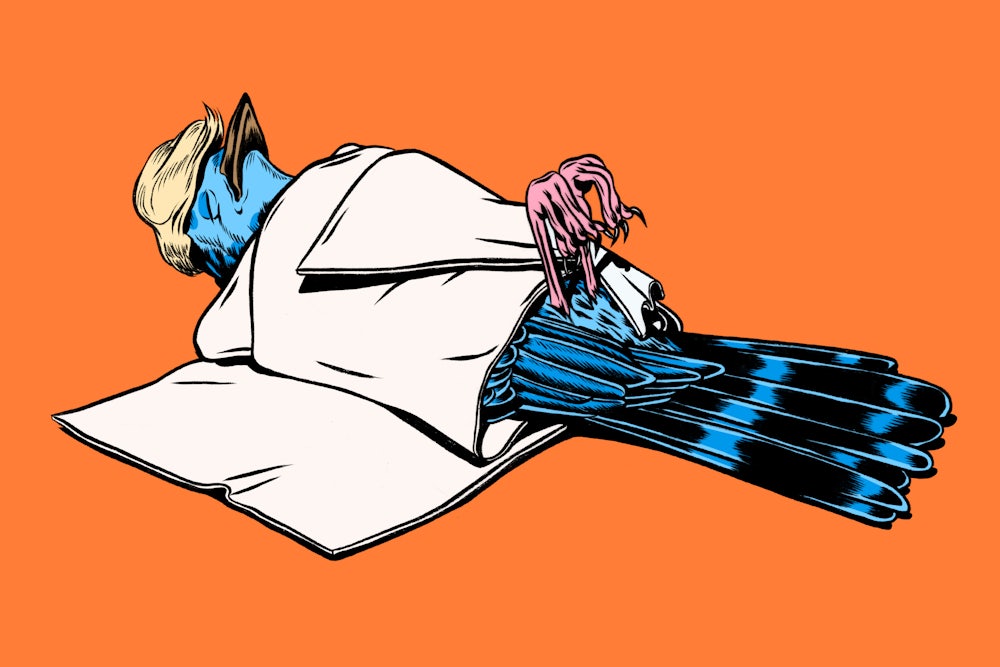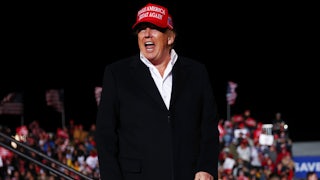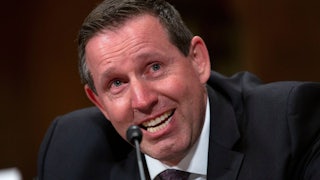In a recent quest to avoid paraphrasing while writing an article about Donald Trump’s relationship with Big Tech, I went in search of a late 2020 tweet in which he promised to veto (seemingly out of spite) a national defense bill unless it terminated part of the Communications Decency Act. I knew a message had once existed, but instantly I came up short. Trump’s Twitter feed had vanished.
On January 8, 2021, Twitter permanently suspended Trump from his favorite social platform “due to the risk of further incitement of violence” following the insurrection at the U.S. Capitol. In the blink of an eye, Twitter not only revoked Trump’s ability to share 280-character missives but removed all of his previous messages. Around the same time, Trump also lost access to Facebook, Instagram, Snapchat, YouTube, and Twitch, with some of those also deleting his history of messages.
The past year has been comparatively calm online, no longer full of concern that a war could be incited by an errant tweet. But Trump’s absence presents something of a conundrum. During his four years in the White House, Trump’s tweets were treated as matters of grave national and global importance. But now we live without an official record. Years’ worth of online stories and blog posts are littered with phantom spaces where embedded tweets once lived. And without the primary sources, how will historians judge the Trump years?
Throughout his tenure as president, Trump issued 26,236 tweets from his personal handle, @realDonaldTrump. The erratic energy, typos, and unconventional hours left little doubt that, despite the social media staff around the president, the majority had been written in his own hand. Each week, stories were written based on the fact that Trump Just Tweeted. That they came in his own voice offers better historical insight than the carefully spun, though often still controversial, statements from the official @POTUS account. His nonstop dispatches once held the power to shape the course of the country, or at least the next 24 hours of the news cycle. Now no official trace remains.
“The president chose [Twitter] as his principal vehicle,” said Timothy Naftali, a CNN presidential historian and professor at NYU. “He used tweets the way some presidents used executive orders.... It would [be] impossible to reconstruct the Trump presidency without tweets.”
The deletions pose a particular problem for online publications, which spent four years posting an endless series of stories embedding Trump’s tweets into articles. Now, in a private-sector twist of Orwellian government censorship, articles include hyperlinks that lead to censored content and a message stating “this Tweet is from a suspended account.”
One 2017 CNN article opens by quoting an infamous Trump tweet: “Despite the constant negative press covfefe.” The story links to a follow-up tweet where Trump urged followers to guess at the true meaning of the nonsensical syllables. But clicking on the link provides no such urging—it’s gone.
Erasing the original record of Trump’s invectives also poses the risk of absolving the former president of his many troubling statements made before and while in office. Amid his feuding with the media, many of Trump’s tweets were overtly racist, sexist, ableist, nativist, or just outright offensive. There were the plethora of anti-Barack Obama birther tweets before he took office. Or his insistence on referring to Covid-19 as the “China Virus.” There were the times he’d retweet white nationalist accounts. He once tweeted that a group of Democratic women of color in the House should “go back and help fix the totally broken and crime-infested places from which they came.” And of course, we can’t forget when he denied the outcome of the 2020 election and amplified hateful rhetoric that led to the Capitol insurrection and, ultimately, his Twitter ban. If that primary record is gone, does it whitewash who the man sitting in the Oval Office really was—and who he would still be should he run again in 2024?
The lack of primary sourcing creates a loss of accountability, said John Davenport, a professor of political philosophy at Fordham University. As major social media platforms attempt to retain their status as forums rather than news curators, however, “the only remedy we have so far is the crude one of exercising their right to deplatform people,” he said. Suspending users is Twitter’s right as a private company, Davenport noted. But historical archives of consequential statements are crucial to creating an accurate record for journalists and historians to reference.
Historians are used to working with incomplete documents, Naftali said. It lessens the quality and completeness of the record, yet it can be done. But beyond making historians’ jobs harder, the absence of Trump’s original tweets has broader consequences. “It was an unprecedented use of social media by a president,” Naftali said. “And even though the letter of the Presidential Records Act does not include this platform, its spirit does. And his use of this tool, as documented by his tweets, should be preserved forever. Not just for historians, but for every American.”
In January 2018, a project by the Library of Congress to catalog all public text posted on Twitter was abruptly discontinued. The volume of tweets had increased too significantly, and storing the full archive had become a herculean task, the Library of Congress stated in a blog post. Moving forward, “the tweets collected and archived will be thematic and event-based, including events such as elections, or themes of ongoing national interest, e.g. public policy.” But the library’s collection only includes text from tweets, no associated images or links—a markedly incomplete record of an increasingly visual medium, one where Trump’s controversial inclusion of a highly classified satellite image in a 2019 tweet would not be captured.
As a potential solution, Davenport suggested platforms like Twitter could maintain a legally accessible record of their archives, or at least of posts from members of government—and that Congress could require this by law. Naftali, similarly, proposed that the National Archives create a mirror copy of all of Trump’s tweets from his presidency, by either public service from Twitter or a subpoena from Congress, to preserve and protect the historical record.
In the meantime, private outlets have stepped up to fill the void. ProPublica’s “Politwoops’’ still has a record of each tweet Trump deleted during his presidential campaign and time in office. The Wayback Machine and thetrumparchive.com provide valuable, fairly comprehensive records of the missing tweets.
For now, future historians are relegated to a digital he-said-she-said. Even with these archives, we are unable to view Trump’s tweets in situ, left with replies desperately missing context. And thanks to the alterability of online journalism, there are no secure standards for how to keep the language identical to the original, primary source. Rather than being written by the victors, history, it seems, may be left up to the imagination.
This article appeared in the March 2022 print edition with the headline “Bye Bye Birdie.”






